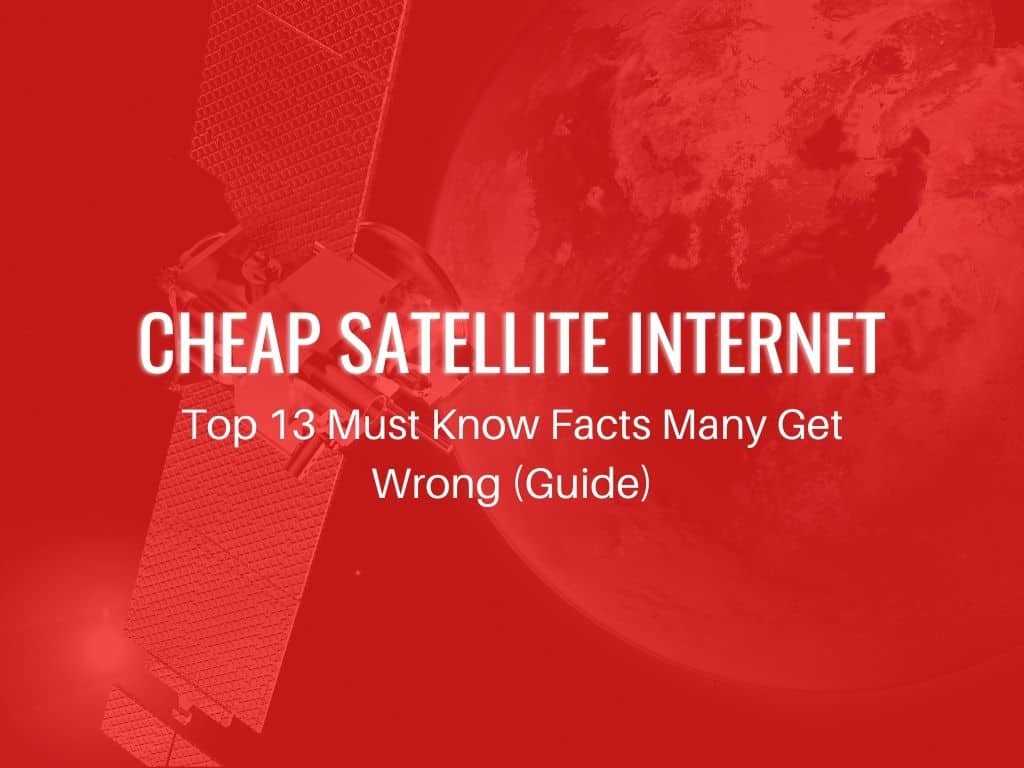Satellite Internet has come a long way since its conception. From being a luxury afforded by only a few to becoming a competitive market where every penny counts, the landscape has evolved significantly. If you’re searching for the cheapest satellite internet, you’ve come to the right place.

The adoption of satellite internet has been steadily increasing, especially in remote areas. According to the Satellite Industry Association, revenues from satellite broadband grew 20% globally in 2020.
With companies like SpaceX and Amazon investing in Low Earth Orbit satellites, we can expect faster speeds, lower latency, and broader coverage in the future, potentially revolutionizing global connectivity.
So it the right time to get in now?
TL;DR: The cheapest satellite internet can be found by comparing different plans, understanding various technologies, and considering factors like installation costs and potential pitfalls. The benefits of opting for a cheaper plan include affordability and increased accessibility. Scroll down to compare the providers.
Scroll down to get a detailed answer
Table of Contents
How to Compare Different Satellite Internet Plans
Comparing satellite internet plans isn’t much different from comparing mobile data plans. You want to look at the cost, data caps, and speeds that each provider offers. A lower price doesn’t always mean a better deal. The real value comes from balancing cost with the quality of service.
| Satellite Internet Provider | Data Caps | Speed | Additional Perks |
|---|---|---|---|
| Starlink | No hard data caps | Up to 150 Mbps | No long-term contracts, lower latency |
| HughesNet | 10-50GB per month (depending on plan) | Up to 25 Mbps | Bonus Zone: Extra 50GB/mo of data (2am-8am) |
| Viasat | “Unlimited” (speeds reduced after data threshold is reached) | Up to 100 Mbps | Free zone: Extra 3 hours of unmetered internet per day |
| OneWeb (expected) | Unknown | Unknown | Expected global coverage |
| Amazon’s Project Kuiper (in development) | Unknown | Unknown | Expected global coverage, backed by Amazon’s infrastructure |
Benefits of Choosing Cheaper Satellite Internet
Choosing cheaper satellite internet means more accessibility and savings. This affordability opens doors for people in remote areas, where traditional wired internet may not be available. Lower costs also mean that you can divert the savings to other areas of your budget.
Different Types of Satellite Internet Technologies
It’s crucial to understand the types of satellite internet technologies to make an informed choice. There are two main types: Geostationary (GEO) and Low Earth Orbit (LEO).
GEO satellites are stationed 22,000 miles above the Earth’s equator, providing widespread coverage but suffering from high latency due to the distance. Providers like HughesNet and Viasat use GEO satellites.
LEO satellites, used by Starlink, orbit much closer to Earth, reducing latency and potentially increasing speeds. However, their coverage is less extensive due to their lower orbit.
Considerations When Shopping for Cheapest Satellite Internet
Before you leap for the cheapest satellite internet, there are a few things to consider. Look out for hidden costs such as equipment rental or installation fees. Data caps are another critical aspect. Low-cost plans may come with severe data restrictions, impacting your internet usage.
Installation Process for Cheapest Satellite Internet
Installing satellite internet involves mounting a dish on your property and connecting it to your modem. While it sounds straightforward, it requires precise alignment for optimal signal reception. Many providers offer professional installation, but this can come with additional costs.
Common Pitfalls with Cheapest Satellite Internet Plans
Cheaper satellite internet plans can have their pitfalls. Low-cost plans often come with slower speeds, stricter data caps, and long-term contracts. Latency can also be an issue, particularly for real-time applications like online gaming or video calls.
Below is a table summarizing the crucial points:
| Aspect | Consideration |
|---|---|
| Cost | Lower price might come with reduced speed and stricter data caps |
| Installation | May involve additional costs |
| Data Caps | Cheaper plans often have stricter data limits |
| Latency | Can be an issue for real-time applications |
Fees with Satellite
Satellite internet fees can add significantly to the total cost of your service. Initial costs may include an installation fee, which covers the setup of your satellite dish and modem. A recurring monthly cost you may encounter is the equipment lease fee for the modem and satellite dish.
If you decide to terminate your contract early, an early termination fee may apply. Additionally, service calls for repairs or adjustments might incur a fee.
Lastly, if your usage exceeds your monthly data cap, you might be charged an overage fee or experience reduced internet speeds. Always check with your provider for a detailed fee structure.
| Fee Type | Possible Costs | Description |
|---|---|---|
| Installation Fee | $100 – $200 | The cost of installing the satellite dish and modem. Some providers waive this fee with certain packages. |
| Equipment Lease Fee | $10 – $15/month | Monthly cost for renting the satellite dish and modem from the provider. |
| Early Termination Fee | Up to $400 | Fee for cancelling the service contract before the agreed-upon period. |
| Service Call Fee | $100 – $200 | Fee for a technician’s visit for any repairs or adjustments after installation. |
| Data Overage Fee | Varies | Fee for exceeding your monthly data cap. Some providers may not charge a fee but significantly slow down your internet speed. |
Conclusion
While the allure of cheap satellite internet is undeniable, it’s essential to make an informed choice. By carefully comparing plans, understanding the technologies, and being aware of potential pitfalls, you can find a plan that fits your needs and budget.
Is there a competitor to Starlink?
Yes, there are several competitors to Starlink, including traditional satellite internet providers like HughesNet and Viasat. Additionally, Amazon’s Project Kuiper is another emerging competitor in the LEO satellite internet market.
How much is satellite internet access?
Satellite internet access can range from around $30 to over $100 per month, depending on the provider and the plan. The cost typically depends on the speed and data limits of the plan.
Is there any satellite internet with unlimited data?
Currently, most satellite internet providers offer plans with data limits. However, some providers like Viasat offer “unlimited” plans, where speeds are reduced after a certain data threshold is reached.
Can you get satellite internet everywhere?
Yes, one of the main advantages of satellite internet is its availability. As long as you have a clear view of the sky, you should be able to get a satellite internet connection, making it ideal for rural and remote areas.


